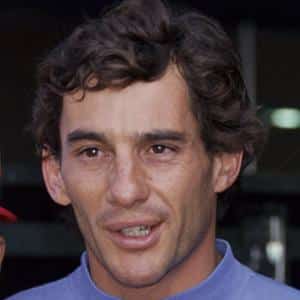How Senna overturned the F1 odds in 1993 with underdog McLaren MP4/8
When McLaren lost its Honda power unit in 1992, Ayrton Senna’s interest in the team evaporated. But as Adam Cooper tells, he was paid big to stay in ’93 and gave Williams a fright with the MP4/8
DPPI
It might not have won the 1993 Formula 1 World Championship, but nevertheless the McLaren MP4/8 holds a special place in the history of F1. Ayrton Senna’s last winning car, it took the Brazilian to five memorable victories in a season that should really have seen the sort of domination by the Williams FW15C that the Red Bull RB19 demonstrated in 2023.
Of course Senna’s special talent was a big part of the equation, no more so than at a soaking Donington Park, the scene of the most famous of his quintet of race wins.
However the car played a role too. With its compact Ford HB V8 and a simple but effective active ride system the MP4/8 was a nimble and very efficient piece of kit that Senna was able to exploit to the maximum while enjoying an underdog status that was unfamiliar to him.
Fondly remembered by those who worked on it, the car was a one-off, the only Ford-powered model in an era when Ron Dennis was juggling manufacturers and always seeking an advantage. And what’s more remarkable is that the engine choice was a last-minute compromise after the withdrawal of Honda left McLaren searching for an alternative supply.
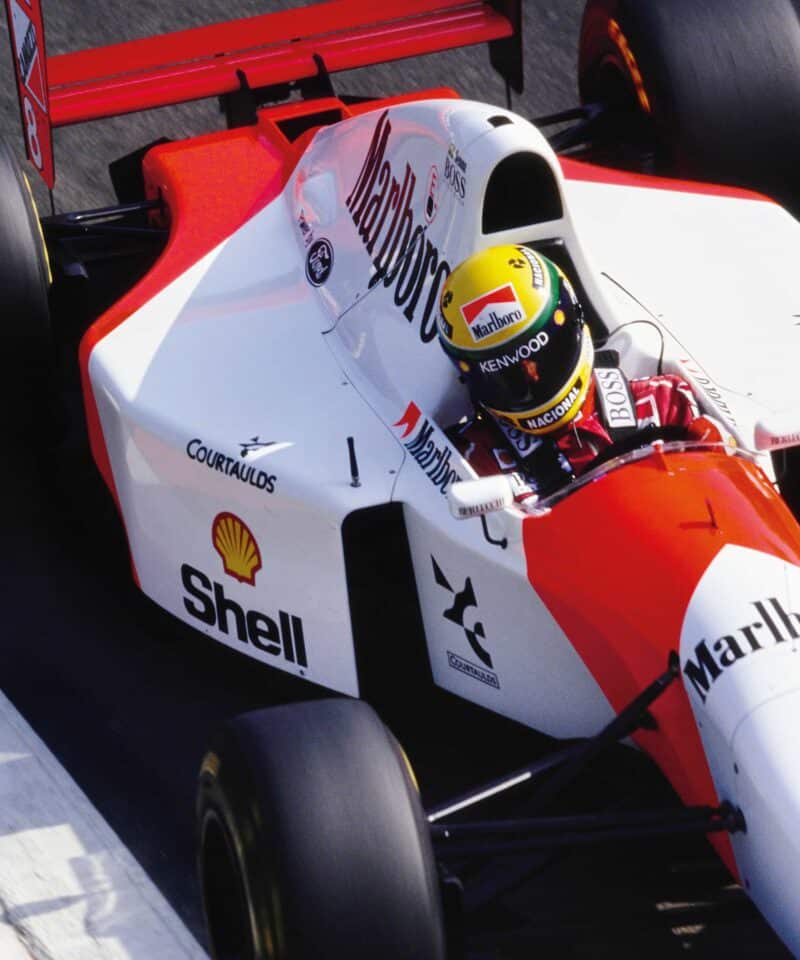
Senna in qualifying at Monza. Disaster struck during the race, colliding with Martin Brundle’s Ligier in the early stages – both were out
Getty Images
It was at the 1992 Italian Grand Prix that Honda formally announced it would be leaving F1 at the end of the season.
“What I didn’t know was that they had telephoned Ron earlier in the year and told him that they were thinking of not carrying on,” recalls then McLaren head of operations Martin Whitmarsh. “But Ron hadn’t told me, and also Ron was in denial – he didn’t believe it. He thought it was just a positioning statement, part of some negotiation.
“Then [Honda boss] Mr Kawamoto came to Monza. Ron and I were in the motorhome, and he said, ‘I’m just confirming we’re stopping.’ I was, ‘Eh? We’ve just won four back-to-back world championships, you can’t stop.’ He said, ‘Winning is not enough.’ I thought what else do you want us to do?
“At that time, September, we weren’t working on anything at all, because as far as I was concerned, it was a bolt from the blue. Honda subsequently told me that they’d told Ron, but Ron wasn’t listening. Ron would always say we didn’t know until Sunday morning in Monza, but I believe they did tell him. Ron didn’t always listen!”
With the first race of 1993 just six months away McLaren urgently required a new supplier. One option was to buy Ligier and strip out the French team’s Renault deal, and that route was explored by McLaren shareholder and TAG boss Mansour Ojjeh. When it proved to be too complicated the Ford HB V8 emerged as the only viable alternative.
“The good thing about the McLaren system was its simplicity”
“We were scrambling around, and I think I signed the customer Cosworth deal in December,” says Whitmarsh. “It was pretty late in the day. We started designing for the Cosworth before we had the contract.”
Ford was the works partner of Benetton, whose boss Tom Walkinshaw was underwhelmed about having to share the engine with a serious rival. The compromise was that McLaren would not have the latest spec, and that would be a source of tension for much of the year.
The last-minute confirmation made life difficult for the Woking drawing office. On the plus side the neatly packaged V8 was lighter and smaller than the Honda V12 that the ’93 car had initially been designed for, and required less fuel and less cooling. All of that helped to move things in the right direction after a tricky year with the MP4/7, which had been outclassed by the Williams FW14B.
“We were designing the car without knowing what the engine was, so there were a variety of different lengths and fuel consumptions to account for,” say chief designer Neil Oatley. “From memory the HB was 4in to 5in shorter, and the consumption was a lot less than the V12 Honda. The car was schemed out with fairly conservative radiator sizes, not far from where we’d be with the V12, so it was fairly easy to make them smaller.”
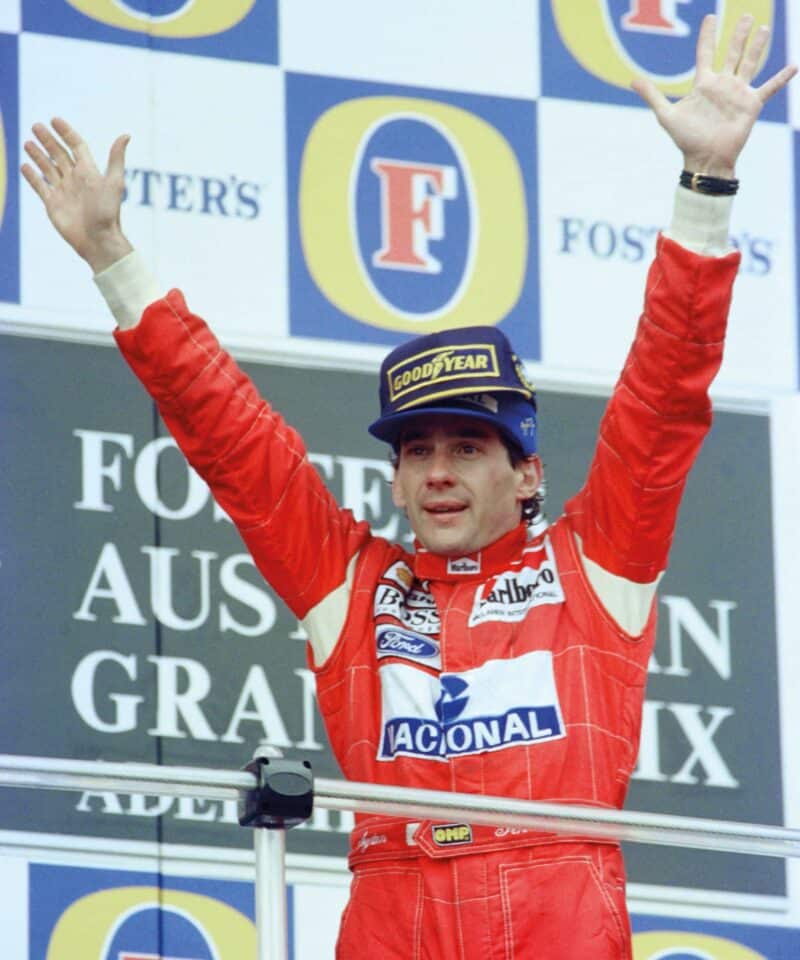
Senna’s final F1 victory, Adelaide, November
Getty images
“Obviously we came from the Honda V12,” says then head of aerodynamics Henri Durand. “The MP4/7 was not very successful by our standards. At the time it was a disappointment, for many reasons. The architecture in itself was pretty demanding, 235 litres of fuel, a lot of cooling, and as a result a long wheelbase. We had struggled a little bit, scratching our heads, on how we treated the car around the stall area.
“You go to MP4/8, and we have a small engine, not very thirsty, cooling was never an issue, and you have active suspension which enabled you to put the car anywhere you wanted to put it. So it was a little bit of a change in environment! On MP4/7 we hadn’t gone as far as Williams had in terms of the high nose, etc, and we corrected that with MP4/8. There was a lot of different evolution in one go. It had much more forgiving architecture, and a much shorter wheelbase.”
Along with the engine Honda’s departure meant the loss of the complex active ride system that the Japanese manufacturer had been working on with McLaren, so the team had to start afresh with its own project. It was handed to Pat Fry, who had just arrived from Benetton, where he’d led the active programme.
“Pat was really the guru of the active ride,” says Whitmarsh. “We had a very complicated Honda system before, which was never successful, and we went for a much-simplified system. I think Pat did a bloody good job on it.”
“When I got there, there was some basic hardware designed, but it was all in the process of being manufactured,” Fry recalls. “And nothing had been started in terms of the control side of it, the control tuning and all of that.
“The good thing about the McLaren system was its simplicity. You didn’t worry about trying to tune the damping and being clever. Effectively you measured the load on each damper, and from that you calculated what the spring compression would be so you could compensate for that. The whole thing was effectively segmented, as we called it. You’d pass the lap trigger, and then every metre around the track the car would do something different. The parameters in race engineering terms were front ride height, rear ride height, and that was about it to start with.”
Honda’s departure also obliged McLaren to develop its own control systems via sister company TAG Electronics, which hitherto had been working with customers such as the Mercedes sports car team.
“Before it was hire the best drivers, do the best aerodynamics, make a stiff chassis, tweak the dampers and go and win a championship,” says Whitmarsh. “In about 1990 control systems started to become a performance differentiator, and as we saw it at the time. You could either partner Magneti Marelli or Bosch, and try to get something from them, or develop your own in-house electronics, which was the Williams approach. We went the latter route.”
“For the gearbox we’d been running a TAG unit with the Honda engine in 1992,” says Oatley. “And then the full engine control unit was adopted by force majeure for 1993. There was no other choice. It wasn’t that big an issue. Cosworth were straightforward people to deal with to link those two together.”
Dennis had another challenge over the winter. Senna was out of contract, and with Honda gone the three-time world champion was playing hardball over remaining with the team in 1993. It didn’t help that Alain Prost was returning from a year out to join Williams for whom Nigel Mansell had been so dominant in 1992, a seat that Ayrton himself had coveted.
“As soon as Honda left, he didn’t want to continue,” says Whitmarsh. “Like any driver, you want a works deal. I think he was right.”
Senna eventually agreed to an initial deal to do the first five races for $5m – the figure Dennis claimed he had left in the pot after paying for the Ford engines – but on the proviso that the money hit his account on time. Over the early races of the season there would be a ‘will he or won’t he show up?’ soap opera.
“It was a million a race,” says Whitmarsh. “In 24 and a half years I was at McLaren we were profitable in F1 and our other businesses every single year apart from 1993, when we lost £1.5m, and we were paying Ayrton $1m a race.”
In the other seat was F1 rookie Michael Andretti, the 1991 CART champion and the personal choice of Dennis for the job.
“Over the early races of the season there would be a ‘will he or won’t he show up?’ soap opera”
However the team boss hedged his bets by also hiring Mika Häkkinen, intimating to the Finn that he might be racing sooner rather than later. As well as undertaking a massive testing programme the former Team Lotus driver would be a handy standby should things not work out with Andretti, or indeed Senna.
In the hands of Prost, the Williams FW15C proved to be the dominant force from the start of the season, at least over one lap. However having finished runner-up in the opening race in Kyalami, Senna then scored superb wins in tricky conditions on home ground at Interlagos and most famously Donington, putting himself into an early lead in the championship. The parallel struggles of team-mate Andretti, who kept getting involved in incidents, indicated how much was down to Ayrton.
However Senna owed a lot to the active ride system, which was overseen on race weekends by Fry and Giorgio Ascanelli, and which underwent an upgrade after four races.
“The limitation on that car was the engineer’s brain,” says Fry. “It also auto upshifted and auto downshifted, and you could segment out various bits. It was a complete nightmare of numbers that you had to get into. But so powerful, and such a great way to learn about engineering a car.”
Meanwhile Whitmarsh made sure that Senna’s success had the full attention of Ford.
“We had wire spring valves at the beginning of the year, and we were being fended off by Tom Walkinshaw,” says Whitmarsh. “We got Ford to agree to giving us air valves, because we were quicker than the Benetton with a lesser engine. We had the pneumatic valves given to us for Imola, but Walkinshaw flew to Detroit and asked Ford to withdraw them. We went to Imola and had to take the pneumatic valves out and go back to wire spring engines.
“We designed a complete top end to the engine at one stage. Typical us, we decided we’ve got to do something! So we designed a butterfly system for it. The Cosworth chief designer didn’t release the power curves to Benetton, but eventually I managed to beat them up and get the power curves. We were offering Cosworth money as a customer to enhance this deal but it was politically difficult.”
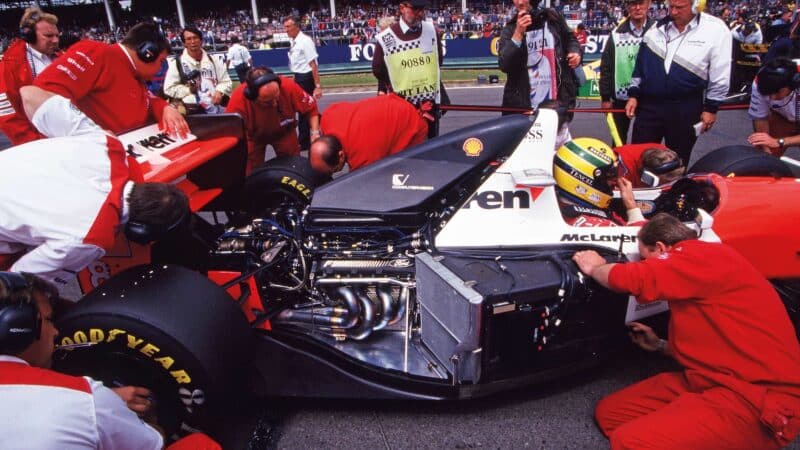
Silverstone, 1993, but Senna would only score two points for fifth… advantage Prost.
Senna would score his third win of the year in Monaco – his sixth in the principality – after an active glitch on a kerb had triggered a huge crash in practice.
It was only after he retired at the next race in Montreal that Prost relieved him of the championship lead. With Damon Hill getting up to speed in the second Williams and Michael Schumacher shining at Benetton life became harder for Senna, and in the middle of the season he struggled even to finish on the podium as Prost marched towards the title.
“His nemesis had 60hp more than him,” says Whitmarsh of Senna. “When you are in the car and you reach the rev limiter at 10,500 or something and you hear a Renault at 13,000rpm, it must be a bit demoralising!”
It didn’t help that the team’s ageing National Physical Laboratory wind tunnel in Teddington was out of commission for six weeks mid-season while undergoing a much-needed upgrade.
“We had to stop development,” Durand recalls. “It was difficult to understand it from a driver’s standpoint. Ayrton was obviously pushing very hard. It’s one of those things where you need to bite the bullet and do it.”
In June, McLaren strengthened its technical team with the arrival of new head of R&D Paddy Lowe, who had been involved in active and other projects at Williams. He had a unique insight into the strengths of the two cars.
“Aerodynamically, the McLaren was nowhere near as strong as the Williams, because I knew the numbers on both,” Lowe says. “But I think the suspension was pretty good. The car was nimble and light, and had good mechanical properties. It was structurally efficient, and stiff.
“It would have been down on power and down on aero – so how did it do what it did? It must have had good mechanical properties compared to the Williams.”
In the summer the sport was rocked by a ban on driver aids for 1994, but Lowe still pushed on with a new project, even though it would have a short shelf life.
“It’s the car in which Senna demonstrated his true greatness”
“I could see that there was an opportunity to put power assistance on the brakes,” he says. “Knowing that ABS, which I knew Williams were doing, would be illegal the following year, it was a question of what could we do that’s simple and quick? We decided just to do a simple power assistance for the brakes. It took three races to develop and build it. We got it on the car for Portugal, Japan and Australia.”
McLaren also squeezed more performance out of the HB as the season went on, having finally gained use of the pneumatic valve version that Walkinshaw had been keen to keep for Benetton’s use.
“Because Ron was buying these engines, he could do what he wanted,” says Lowe. “So we had a special cylinder head made, and we could also run the engines harder and do things that they wouldn’t let the works team do, because Ron would say, ‘It’s my engines, it’s my money, so we’ll do what we want.’ Being able to run them harder at higher revs – we didn’t have to follow their rule book.”
There was much going on in the McLaren camp in the latter part of the year. A B-spec version of the car was tested with the Chrysler-financed Lamborghini engine and proved so promising that Senna wanted to race it straight away, although Dennis would anger the Detroit giant when he decided instead to join forces with Peugeot for 1994.
Meanwhile, after finally making the podium in Monza, Andretti was eased out of the team. Häkkinen was rewarded for his work in testing as he replaced the American in Estoril – where he gave Senna a shock by outqualifying him.
Senna then went on to win another rain-affected race in Japan before ending his season with a victory in Australia, his last start for McLaren before he moved to Williams to replace the retiring Prost. The power-assisted brakes gave the car a boost in those final races.
“They were able to really stand on the brakes,” says Lowe. “Particularly at the beginning of the braking period where you’re trying to get the pressure up as quickly as you can. They could do it much quicker and to a higher level. It was worth a lot of lap time.”
Senna’s death at Imola, six months after that Adelaide victory, would give the MP4/8 extra resonance as his last winning car – and arguably the one in which he demonstrated his true greatness more than any other.
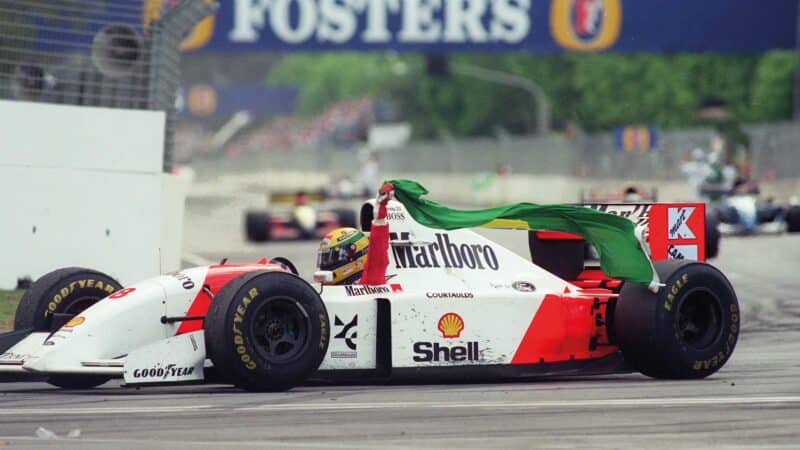
Senna was the right fit for the MP4/8 – a driver who was able to adapt to the car’s characteristics, but it wasn’t to Mika Häkkinen’s taste
In 2018 his Monaco chassis was auctioned by Bonhams for £3.6m, including commission. It was reported at the time that the purchaser was Bernie Ecclestone, but the secret buyer behind the scenes was Sebastian Vettel, who rather awkwardly was a Ferrari driver at the time. Having tested it in private he gave the car a public outing at the 2023 Goodwood Festival. The four-time champion is not the only person for whom the car is special.
“It’s probably one of my favourite cars I’ve worked on,” says Oatley. “The technology was there, but compared to today, it was very simple – it was more manageable by a very small group of people.
“It was a fun year, but frustrating for part of the middle of the season until we got the better engine and made more advances with the suspension and braking. It was really pleasing how it was in those last few events. As a team we were melded together, and it all worked very well. It was a great group of people and a fun car with all the toys available.”
“It’s my favourite McLaren,” Durand agrees. “It was a nice car, respectable compared to the Williams. You could debate which chassis was the best at some point in the season. You couldn’t in 1992. I loved it because it was simple, it was not convoluted, it just made sense.”
“For me it was a great year,” says Fry. “It was an engineer’s dream. Certainly some of the other active cars I’ve done were great fun, a good science project, but not to the level where you could actually take it racing. But that one was simple, if you look at it. It was a beautiful, simple thing.”
Whitmarsh isn’t the type of guy to value F1 memorabilia. However when some years later the Donington steering wheel appeared on his desk – with a certificate of authenticity for him to sign as a gift for a McLaren sponsor – he decided to hang onto it.
“I’ve got quite a soft spot for this particular car,” he says. “Because in the history of McLaren, if there was one car that I might claim that I shaped quite a lot of, it’s that car. And it’s one of the reasons I’ve got Ayrton Senna’s Donington steering wheel.”
